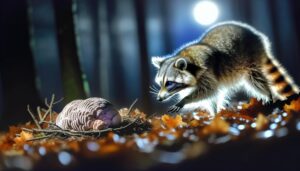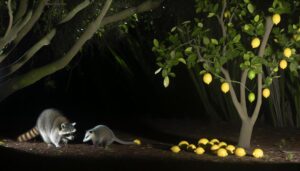How Do Raccoons Wash Their Food Before Eating?
Raccoons do not wash their food for cleanliness; instead, they engage in a behavior called 'dousing.' This involves manipulating food in water, primarily for tactile exploration. Their highly sensitive forepaws help them examine food textures, which can enhance their foraging efficiency.
Studies suggest this behavior also aids in hydrating and softening the food, not specifically related to hygiene. Such behaviors are observed more frequently in environments where water is readily available.
By understanding the adaptive nature of this instinctual practice, one can appreciate the complex feeding strategies of raccoons more fully.
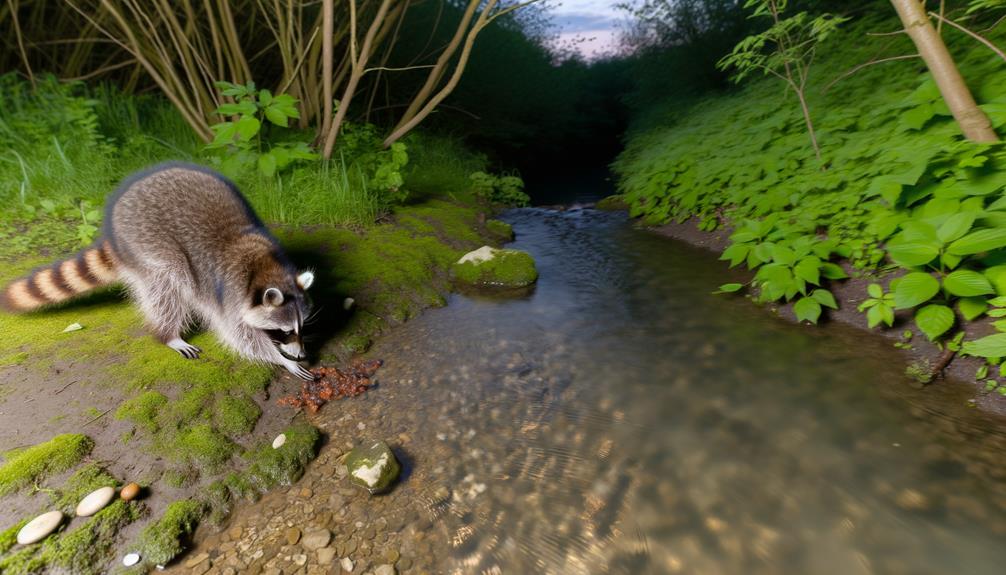
Key Takeaways
- Raccoons frequently engage in a behavior called 'dousing', often mistaken for washing food.
- This 'washing' behavior is observed in both wild and captive raccoons.
- The behavior is more about tactile exploration than actual cleaning.
- Raccoons 'wash' food irrespective of its cleanliness, suggesting other motives.
- The availability of water and the type of food influence the likelihood of this behavior.
The Myth of Washing Food

Contrary to popular belief, the notion that raccoons habitually wash their food before consumption is largely a myth. This misconception likely stems from observations of raccoons handling food items near water sources.
Scientific studies indicate that raccoons possess highly sensitive touch receptors in their paws, enabling them to identify and manipulate objects effectively. When near water, their behavior appears akin to washing but is primarily a mechanism to enhance touch sensation.
This behavior is not consistent across all environments and is absent in raccoons that do not have access to water. Hence, the idea of raccoons washing their food is an anthropomorphic interpretation rather than an accurate representation of their natural behaviors.
Understanding this distinction is vital for accurate knowledge dissemination.
Raccoon Feeding Behaviors
Raccoon feeding behaviors exhibit a high degree of adaptability and opportunism, reflecting their omnivorous diet and ability to thrive in diverse environments. These behaviors include foraging for fruits, nuts, insects, small vertebrates, and human-provided food sources such as garbage.
Raccoons use their highly sensitive forepaws to manipulate and examine potential food items, often in water, which enhances their tactile perception. This tactile foraging is essential for identifying edible substances and effectively exploiting available resources. Their feeding strategies are influenced by seasonal variations and local food availability, demonstrating a flexible approach to sustenance.
Consequently, raccoons can inhabit urban, suburban, and rural areas, showcasing their remarkable ecological plasticity and resilience in various habitats.
Scientific Observations
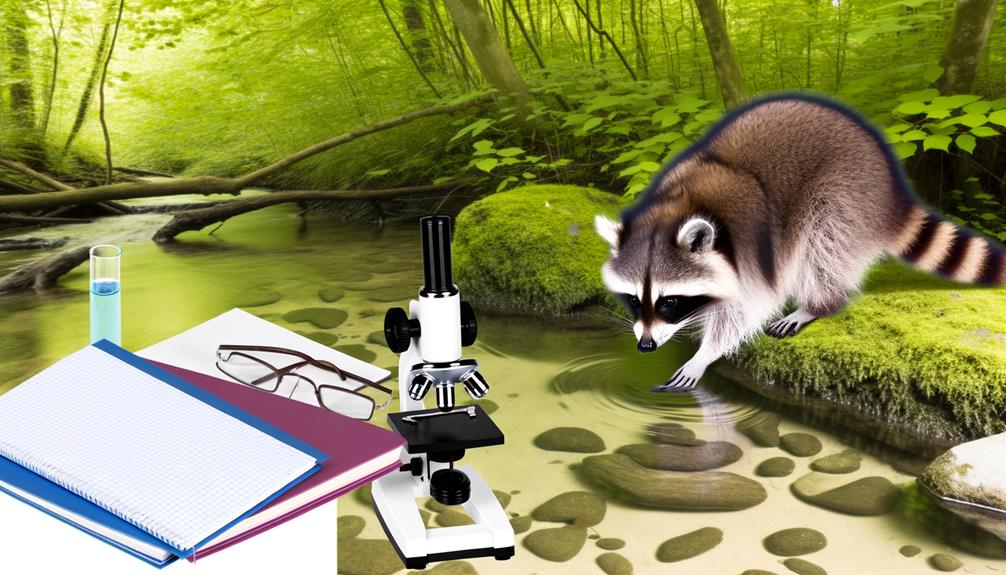
Observations from scientific studies provide valuable insights into the peculiar behaviors raccoons exhibit, particularly their habit of manipulating food items, often perceived as 'washing,' before consumption.
Researchers have documented raccoons frequently dipping and handling food in water, a behavior termed 'dousing.' This behavior has been consistently observed both in wild and captive settings. Detailed field observations and controlled experiments reveal that raccoons engage in this activity irrespective of the cleanliness of the food.
Additionally, scientists have noted that raccoons possess highly sensitive forepaws, which they use to explore and manipulate objects with remarkable dexterity. These findings suggest that the so-called 'washing' is a complex behavior, potentially linked to the raccoon's tactile exploration rather than hygiene.
Possible Explanations
To understand why raccoons appear to wash their food, researchers propose several hypotheses. These include:
- Instinctual cleaning behavior.
- The sensory enhancement theory.
- The need for hydration and softening of food items.
Each of these points offers a potential explanation based on observable behaviors and physiological needs of the species.
Instinctual Cleaning Behavior
Despite the common belief that raccoons wash their food before consuming it, this behavior may actually be rooted in instinctual cleaning actions that serve multiple potential purposes.
One possible explanation is that these actions are a method of removing dirt, parasites, or other contaminants from their food. This cleaning behavior could be an evolutionary adaptation, enhancing the raccoons' overall health by reducing the risk of ingesting harmful substances.
Additionally, the tactile sensation of water may stimulate their highly sensitive paws, which are vital for exploring and manipulating their environment. Therefore, the act of 'washing' food may be more accurately described as a complex instinctual behavior aimed at ensuring food safety and leveraging their keen sense of touch.
Sensory Enhancement Theory
The Sensory Enhancement Theory posits that raccoons' behavior of manipulating food in water may primarily serve to heighten their tactile perception, allowing them to better assess the texture and edibility of potential food items.
This hypothesis is grounded in the understanding that raccoons possess highly sensitive tactile receptors in their paws. By wetting their food, they may activate these receptors more effectively, thus gaining a more refined sensory input.
This behavior could be particularly advantageous in distinguishing edible items from non-edible ones, especially in low light conditions or murky environments where visual cues are limited.
Consequently, this tactile enhancement through interaction with water might represent an evolved adaptive strategy to optimize their foraging efficiency and dietary choices.
Hydration and Softening
One plausible explanation for raccoons' tendency to manipulate their food in water is that this behavior may aid in hydrating and softening the food, making it easier to chew and digest. This theory is supported by observations of raccoons frequently dunking dry and hard food items, such as nuts and grains, into water sources before consumption.
The process of soaking could break down fibrous structures or tough exteriors, thereby facilitating mastication and subsequent digestion. Additionally, water exposure might help dissolve potential toxins or contaminants present on the food surface. This behavior could be an adaptive strategy, particularly beneficial in environments where raccoons encounter a variety of food textures and compositions that necessitate pre-consumption modification for best nutritional intake.
Comparing to Other Animals
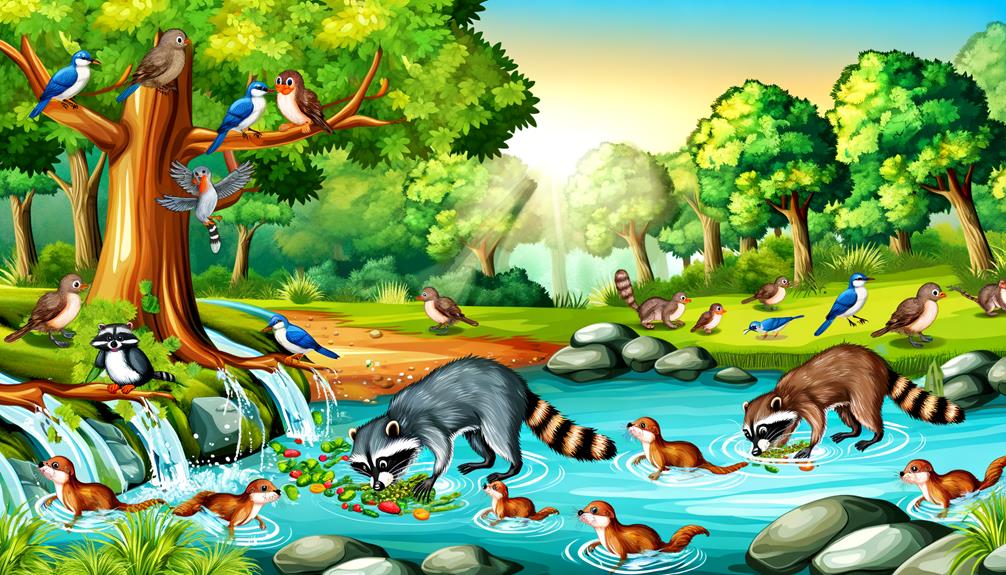
Among various animal species, raccoons exhibit a unique behavior that resembles washing their food before consumption, setting them apart from many other mammals. This behavior is not observed in most other terrestrial animals, which tend to consume food directly without such preparatory actions. For instance, primates may employ tools or their hands to clean food but do not engage in washing. Birds often peck at or shake food to remove debris, yet they do not wash it.
| Animal | Food Preparation Behavior |
|---|---|
| Raccoons | Appears to wash food in water |
| Primates | Use tools or hands for cleaning |
| Birds | Peck or shake food |
| Cats | Lick to clean but do not wash |
| Dogs | Typically eat food as found |
These distinctions highlight the diverse food-handling strategies across species.
Final Thoughts on the Habit
In synthesizing the observational study insights, it becomes evident that the washing behavior of raccoons is not a consistent trait but varies based on environmental factors and food type.
This behavior has important behavioral implications, potentially linked to sensory mechanisms rather than hygiene.
Further research is necessary to fully comprehend the adaptive significance of this habit in raccoon populations.
Observational Study Insights
Extensive observational studies reveal that the behavior of raccoons washing their food is more nuanced and context-dependent than previously assumed. Field research and controlled experiments indicate that raccoons do not uniformly exhibit this behavior across all environments and circumstances.
Factors such as the type of food, availability of water, and environmental conditions influence whether a raccoon will engage in this so-called 'washing' behavior. For instance, raccoons are more likely to dunk food in water when it is sticky or coated with dirt. Conversely, in arid environments or when consuming dry foods, this behavior is markedly less frequent.
These findings suggest that what appears as washing may be rooted in practical, adaptive behaviors rather than a habitual, innate compulsion.
Behavioral Implications
The observed variability in raccoons' food-washing behavior highlights its adaptive nature, suggesting that this practice is influenced by practical needs rather than an inherent instinct. This behavior, known as “dousing,” appears to be contingent upon environmental factors such as the availability of water and the type of food encountered.
| Factor | Influence on Behavior | Observational Evidence |
|---|---|---|
| Water Availability | Increases likelihood | High dousing near water bodies |
| Food Type | Variable | Fruits less likely to be washed |
| Environmental Context | Adaptive responses | Urban raccoons douse less |
The behavioral implications suggest that raccoons are highly adaptable, leveraging their environment to optimize food intake. This adaptability underscores the importance of context in understanding animal behaviors, revealing a complex interplay between instinct and environmental conditioning.
Conclusion
Contrary to popular belief, raccoons do not meticulously wash their food before consumption. Observations reveal that this behavior, often perceived as washing, is more likely a byproduct of their tactile sense and feeding habits.
While the myth endures, scientific evidence dispels this romanticized notion. The raccoon's 'washing' is a mere legend, eclipsed by the intricate reality of their feeding behaviors.
Therefore, the image of raccoons as diligent washers remains an exaggerated fallacy, unsupported by empirical data.

